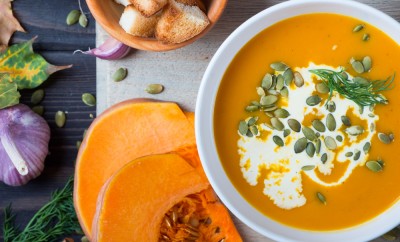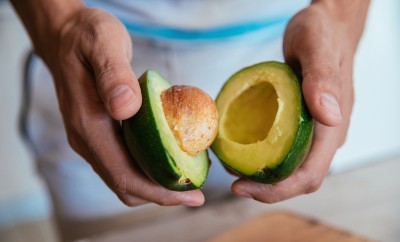Nutrition
A week of vegan groceries for $20

Image: sheff/Shutterstock
One of the most popular arguments against veganism is, “I just can’t afford it.” Actually, you can. If you can afford the standard American diet, you can afford to buy nothing but plants. Vegan staples like rice, tofu, dried beans, vegetables, and (certain) fruits are among the cheapest foods in American grocery stores. Eating a vegan diet can be as cheap or as expensive as you want it to be. You are perfectly capable of spending over $100 a week if you buy things like pre-made vegan cheesecake, pastries, hand pressed veggie burgers, frozen meals, and artisan cashew cream cheese. Thankfully, some dedicated and impoverished vegans taught me how to eat as cheaply as a college kid.
Knoxville boasts several grocery store options for both vegans and the health conscious. In the name of keeping things simple (and gas affordable), I visited the two grocery stores closest to my apartment. One was a run-of-the-mill chain grocery store, and the other a national chain health food store. This particular health food store is my favorite because it offers a bulk section chock full of cheap dried goods. In the bulk section, you’re not stuck buying an entire pound of prepackaged goods. You can buy as much, or as little, as you need. Otherwise, the prices were fairly comparable between the two stores. But armed with only a $20 bill, I didn’t have time for comparable. I needed dirt cheap.
The first stop at the regular grocery store is produce. When you’re short on cash for the week, make sure to follow the sales and don’t feel like you have to stick to what you are familiar with. Gala apples are not my favorite (Honeycrisp will forever hold my heart) but they’re perfectly fine at $1.59/lbs. out of season. I grabbed all the staples I knew I wanted like potatoes, tomatoes, peppers, a lemon, and bananas, but I also took a few extra vegetables just in case I was able to afford them after everything else was tallied up.
On a typical grocery shopping day, I grab the same twenty or so things and get to checkout station a quickly as I can. But this time I painstakingly walked down each aisle so I could see everything and make sure I didn’t miss any sales. This method paid off big time in the international aisle when I found a pack of 30 corn tortillas for $1.50. I ditched the $3 whole wheat bread and tried to imagine what on earth I could do with 30 tortillas. I decided to figure that out at home.
When I made it to the canned goods aisle, I had nothing organic in my cart so I decided to buy the cheapest organic pasta available. The grocery store’s organic spaghetti was $1.99, but I knew the health food store had the same amount of organic pasta for $1.29. I decided to wait for the health food store on the pasta and instead checked out the pasta sauce. The house brand was only $1.50! As I gleefully tossed the jar in our cart, my husband chimed in,“Did you check the ingredients list?”
“What? No, it’s just pasta sauce. Why would there be any eggs or dairy in it?”
Well, guess what? There was dairy in the pasta sauce. In fact, every flavor of pasta sauce they offered in the house brand had dairy in it. Frustrated, I resolved to buy house brand pasta sauce at the health food store. All of which was thankfully void of dairy, except for the three-cheese flavor. This incident brings up a lesson that all vegans have to learn one day: check the ingredients list for everything. Dairy and eggs can lurk in the most unlikely places. After the deceitful pasta sauce, I had some luck in the frozen food section where a small bag of vegetable medley (broccoli, navy beans, carrots, cauliflower, red peppers, corn) was on sale for $1.
The health food store was my second stop, and I only intended to buy pasta, pasta sauce, and oats. I had about $6 left and decided to try out a nub of ginger and 2 cups of organic bulk popcorn kernels. With the sale running on the popcorn it turned out to be dirt cheap, and it provided me with four extra snacks I didn’t plan on.
After my visit to both stores, I ended up spending $19.94 before tax, which will differ (sometimes heavily) from state to state. Here’s a breakdown:
Produce:
- Large lemon- $0.79 (each)
- 3 Medium Gala Apples- $1.61 ($1.59/lb. on sale)
- 6 Medium Bananas- $1.32 ($0.59/lb.)
- 1 Cucumber- $0.59 (each)
- 3 Roma Tomatoes- $0.62 ($0.99/lb. on sale)
- 1 Large Green Bell Pepper- $0.99 (each)
- 1 Small Yellow Onion- $0.59 ($0.99/lb.)
- 1 Small Yellow Squash- $0.37 ($0.99/lb. on sale)
- 1 Small Zucchini- $0.50 ($0.99/lb. on sale)
- 1 Nub of Ginger- $0.16
- 4 Medium Carrot Sticks- $0.45 ($0.99/lb.)
Dried Goods:
- Bulk Dried Garbanzo Beans, about 2 cups, 14 oz. – $1.56 ($1.79/lb.)
- Bulk Rolled Oats, about 2 cups, 6.34 oz. – $0.39 ($0.99/lb.)
- Bulk Organic Popcorn Kernels, 1.5 c, 4 oz. – $0.45 ($1.79/lb. on sale)
- Dried Red Beans, 1 lb. – $1.29 (sale)
- Long Grain Brown Rice, 1 lb.- $0.89 (sale)
- Box of Organic Spaghetti, 16 oz. – $1.29
Other:
- Organic Tofu, 14 oz. – $1.59 (sale)
- 30 Count Small (about 5” in diameter) Corn Tortillas, 1 lb. , 11.5 oz. – $1.50 (sale)
- Marinara Sauce, 25 oz. – $1.99
- Frozen Vegetable Medley, 12 oz.- $1.00
*Condiments (ketchup, mayo), spices, salt, oil, and (vegan) butter were not included in my grocery haul because everyone has these items already and they typically do not need to be restocked weekly.
When I finally got home with my two reusable totes of goodies, I immediately set to work meal prepping my hodgepodge of colorful produce, beans, and tofu. What else are Sundays for? First, I did a fast boil of my garbanzo beans so I could make tahini-free hummus in my food processor. Second, I opened, rinsed, and pressed my tofu, then started cutting my onion, green pepper, tomatoes, carrots, and cucumber (and drank some leftover wine) while I waited for my tofu to press. There’s a million ways to make tofu, but this week I decided to dice my drained tofu into tiny cubes, marinate them in soy sauce and rice vinegar (1:3 ratio), batter them with cornstarch, and fry them in a pan with olive oil. This made the tofu more conducive to fitting in the 30 small tortilla wraps I had purchased. I also placed my red beans in water to soak overnight.
Daily Breakdown:
Sunday:
Snack: Cucumber slices and ½ cup hummus
Dinner: Spaghetti, ⅓ cup marinara sauce, sauteed whole squash, whole zucchini, some onion.
Snack: ⅓ cup popcorn kernels cooked on stovetop, salt, 3 Tbsp. canola oil
Monday:
Breakfast: ¼ cup of oatmeal, whole banana (sliced), dash cinnamon, ½ Tbsp. maple syrup
Snack: apple
Lunch: ½ cup cooked red beans, 2 oz. tofu, green bell pepper, ¼ cup rice, onion, tomato, on 4 corn tortillas
Dinner: ¼ package of vegetable medley, ¼ cup rice, ½ Tbsp. butter
Snack: ½ cup hummus and two carrots, sliced
Tuesday:
Breakfast: ¼ cup oatmeal, whole apple (sliced), nutmeg, maple syrup
Lunch: 1 cup mashed red bean salad, 1 Tbsp. mayo, 1 tsp. Dijon mustard, pinch celery powder, minced green pepper, onions, 3 corn tortillas
Snack: ⅓ cup popcorn kernels popped on stovetop, dill, salt, 3 Tbsp. canola oil
Dinner: spaghetti, marinara sauce, 3 oz. tofu
Snack: ½ cup hummus, 3 sliced and fried tortillas, canola oil (chips)
Wednesday:
Breakfast: ¼ cup oatmeal, pinch of sugar, dash of cinnamon & nutmeg
Lunch: ½ cup hummus, ½ cucumber
rice & beans with oregano, Tbsp.. butter, salt, ¼ cup of sauteed minced pepper & onion
Dinner: ¼ package of vegetable medley sauteed, 2 oz. tofu, grated ginger, Spanish rice, 4 corn tortillas
Snack: banana
Thursday:
Breakfast: ¼ cup oatmeal, grated dark chocolate, cinnamon, 1 banana
Lunch: 3 corn tortillas, ¼ vegetable medley sauteed in olive oil, ¼ cup rice, tsp. Dijon mustard
Snack: 1 banana, 1 apple
Dinner: 2 carrots, ½ cup hummus; spaghetti, ⅓ cup marinara
Friday:
Breakfast: ¼ cup oat meal, 1 banana sliced, cinnamon
Lunch: ¼ vegetable medley steamed, ¼ cup rice, 2 oz. tofu, butter, herbs de Provence
Snack: 3 corn tortillas sliced and fried, ½ cup hummus
Dinner: spaghetti, marinara sauce, 2 oz. tofu, ¼ vegetable medley
Snack: ⅓ cup popcorn kernels, 3 Tbsp. canola oil, salt
Saturday:
Breakfast: ¼ cup oatmeal, 1 banana sliced, 1 Tbsp. maple syrup, dash of nutmeg
Lunch: ¼ package of vegetable medley, 2 oz. tofu, ¼ cup rice, ¼ cup cooked red beans, pinch of oregano, pinch of salt
Snack: 1 cup hummus, 4 corn tortillas fried in olive oil
Dinner: Out to eat with family. Otherwise, I would have eaten ¼ cup rice, ½ cup cooked beans, 1 Tbsp. butter, dash of herbs de Provence
Snack: Banana
Leftovers: Marinara sauce, spaghetti, rolled oats, rice, beans, ginger, corn tortillas.
To be frank, I did not enjoy eating the same 20 things for an entire week. Normally I would have thrown in some waffles or chia seed pudding for breakfast. There are also a ton of other meals that could have been made from my collection of vegan goodies. But this is a good exercise in learning how to obtain your basic items in a frugal fashion.
If you literally only have a $20 bill in your hand for your groceries on a given week, find a store that sells dry goods in bulk. Immediately. Usually, health food stores will have bulk sections full of dried rice, beans, nuts, seeds, salt, sugar, tea, pasta, trail mixes, granola, and other grains. If you’re able to bake your own bread or pasta, you can save even more. While I have the time to soak and bake my beans, I do not have the time to make my own bread and pasta.
The bulk section is my favorite place in the grocery store because it gives me the freedom to buy things package free (bringing small reusable bags), for less money, and I can buy as much or as little as I need. Remember that lone $20 bill clutched in your hand? This is the place to spend it. The scoops at my local health food store are about a cup each. A serving of rice is one fourth of a cup, so I know that each scoop will be roughly four servings of rice.
Why not just buy canned goods? Instead of buying canned beans and lentils, opt for the dried version. Canned legumes are inexpensive, but if you buy them dry, and in bulk, they are even cheaper. The only way they could cost less is if you grew them yourself. Dried beans only take a little more time to prepare, most of which is mindless. For most beans, you simply soak them overnight in a covered bowl. Rinse them the next day, place them in a pot of water one inch higher than the beans, bring the water to a boil, then bring heat back down to medium high until they are as squishy as you need them. Canned goods are also extremely high in sodium, and while vegans need not worry about their cholesterol intake, you still have to be conscious of your sodium intake.
Another important factor for consideration is seasoning. Sure, some of the more exotic spices can be expensive, but certain thoughtful purchases, such as ginger, can introduce some much-needed variety to the same foods. This minimizes the monotony of eating the same thing every day. You don’t have to season everything. You could season the tofu differently one day, the rice the next, and then change the seasoning on the beans next. Some stores even have basic spices available in bulk, allowing you to get scant amounts to try before you commit to a large purchase.
The next time you go to the grocery store and have limited funds, just remember to follow the sales, check every aisle, shop in bulk, buy in-season produce when possible, avoid canned goods, and have an idea of what you want to eat that week. It’s never easy for anyone to buy groceries on such a tight budget, but don’t ever let money stand in the way of you making the decision to live out your values and avoid the exploitation of animals.





0 comments